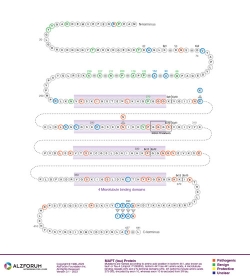Mutations
MAPT N296H
Quick Links
Overview
Pathogenicity: Frontotemporal Dementia : Pathogenic
Clinical
Phenotype: Frontotemporal Dementia
Reference Assembly: GRCh37/hg19
Position: Chr17:44087739 A>C
dbSNP ID: rs63750416
Coding/Non-Coding: Coding
DNA
Change: Substitution
Expected RNA
Consequence: Splicing Alteration
Expected Protein
Consequence: Isoform Shift; Missense
Codon
Change: AAT to CAT
Reference
Isoform: Tau Isoform Tau-F (441 aa)
Genomic
Region: Exon 10
Findings
The N296H mutation leads to a clinical syndrome similar to autosomal-dominant frontotemporal dementia with parkinsonism linked to chromosome 17. It was initially identified in a 62-year-old Japanese man who presented with frontal signs followed by temporal signs and parkinsonism (Iseki et al., 2001).
Neuropathology
This mutation is associated with localized frontotemporal atrophy, including severe neuronal loss in the precentral gyrus. Many tau-positive astrocytes were observed in the cerebral cortex, but no tau-positive neurofibrillary tangles or Pick bodies. Phosphorylated tau accumulated in both neurons and glia, but only rarely assembled into abnormal filaments. Tau isoforms containing four-repeat domains were enriched in the brain (Iseki et al., 2001).
Biological Effect
In addition to causing a substitution of amino acids at position 296, this mutation alters the relative production of 3R to 4R tau isoforms. Specifically, this mutation falls within a region of MAPT that regulates exon 10 splicing, leading to an increase in the relative number of transcripts containing exon 10. This translates into an overproduction of tau isoforms containing four microtubule binding repeat domains (4R tau). The N296H mutation also has been shown to reduce the rate of tubulin polymerization and the extent of microtubule assembly. It has little to no effect on tau filament formation (Yoshida et al., 2002; Grover et al., 2002).
Last Updated: 16 Feb 2023
References
Paper Citations
- Iseki E, Matsumura T, Marui W, Hino H, Odawara T, Sugiyama N, Suzuki K, Sawada H, Arai T, Kosaka K. Familial frontotemporal dementia and parkinsonism with a novel N296H mutation in exon 10 of the tau gene and a widespread tau accumulation in the glial cells. Acta Neuropathol. 2001 Sep;102(3):285-92. PubMed.
- Yoshida H, Crowther RA, Goedert M. Functional effects of tau gene mutations deltaN296 and N296H. J Neurochem. 2002 Feb;80(3):548-51. PubMed.
- Grover A, DeTure M, Yen SH, Hutton M. Effects on splicing and protein function of three mutations in codon N296 of tau in vitro. Neurosci Lett. 2002 Apr 19;323(1):33-6. PubMed.
Further Reading
Learn More
Protein Diagram
Primary Papers
- Iseki E, Matsumura T, Marui W, Hino H, Odawara T, Sugiyama N, Suzuki K, Sawada H, Arai T, Kosaka K. Familial frontotemporal dementia and parkinsonism with a novel N296H mutation in exon 10 of the tau gene and a widespread tau accumulation in the glial cells. Acta Neuropathol. 2001 Sep;102(3):285-92. PubMed.
Other mutations at this position
Alzpedia
Disclaimer: Alzforum does not provide medical advice. The Content is for informational, educational, research and reference purposes only and is not intended to substitute for professional medical advice, diagnosis or treatment. Always seek advice from a qualified physician or health care professional about any medical concern, and do not disregard professional medical advice because of anything you may read on Alzforum.


Comments
No Available Comments
Make a Comment
To make a comment you must login or register.